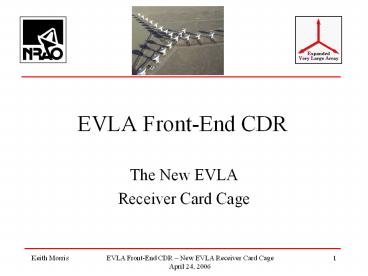EVLA%20Front-End%20CDR%20 - PowerPoint PPT Presentation
Title:
EVLA%20Front-End%20CDR%20
Description:
EVLA FrontEnd CDR New EVLA Receiver Card Cage – PowerPoint PPT presentation
Number of Views:44
Avg rating:3.0/5.0
Title: EVLA%20Front-End%20CDR%20
1
EVLA Front-End CDR
- The New EVLA
- Receiver Card Cage
2
Overview
- The EVLA Card Cage shall
- Provide 8 stages of conditioned LNA bias
- Control and monitor cryogenic sensors
- Interface to Monitor/Control system
- (But allow stand-alone bench testing)
- Mount to EVLA receivers
- Minimize EMI
- Minimize assembly time and cost
3
Block Diagram
4
Pseudo-passive Scheme
- 96 available analog monitor points, selectable in
banks of 3 - Default critical diagnostic parameters
- Gate voltage sums (RCP, LCP)
- 15K stage temperature
- MIB mounted remotely
- No digital signal traffic during observation
5
Card CageEVLA vs. VLA/VLBA
VLA/VLBA EVLA
4 stages of bias/card 8 stages of bias per card
Hard-wired logic Programmable logic
Hand-wired interconnects Backplane/ribbon cable
Clock-driven display Pseudo-passive monitoring
Unique to each Rx band Universal design
AC/digital EMI No AC or fast clocks
Open, custom chassis Modified COTS enclosure
6
Chassis VLA
7
Chassis EVLA
Interim only
8
Wiring VLA
- 250-300 individual solder points
- Wire directions hand- randomized to
prevent EMI due to AC
9
Wiring EVLA
- 6 IDC connections
- 8 solder points
- 16 crimps
- No AC, clocks
10
Enclosure
- COTS Stamped Al VME Chassis
- Pre-assembled with hardware
- 1/3 the weight of extruded aluminum
- 1/4 the cost!
11
Minimizing Assembly
- IDC/Crimp vs. hand-soldering
- Pre-assembled chassis
- Modular, universal design
12
Control/Sensor Card
- Replaces VLA
- Control,
- Sensor and
- Monitor cards
- Altera CPLD
- No fast clock!
- 4 x 6 Eurocard
13
Control PLD
- Communication registers for Digital IO
- 32 x 4 latching input registers
- 32 x 4 output registers
- SPI-compatible
14
Cryogenic State Machine
- 9 sensor comparators
- 4 user-set state commands
- 14-way LED state indicator
- Local/remote control
15
Cryogenic Control
16
AC Relay Box
- Removes AC its EMI from Card Cage
- Allows logicbypass for Fridge
- Separate LEDfor each request
17
8-Stage Bias Card
- Based on GBT 6-stage design
- Allows disabling of stages in banks of 2
- VD, ID, and VG are monitored
- 4 x 6 Eurocard
18
LNA Diode Protection Board
- Accommodates 8 bias stages
- Drain voltage clamped to 6V/-1V
- Gate voltage clamped to 1V/-2V
- Soldered to hermetic feedthrough
19
Receiver ID
- Band code, Receiver S/N, and revision stored in
64kB EEPROM - Spare capacity for textCAL files, bias
settings, etc. - Follows receiver, not Card Cage
20
RF/IF Box Interface
- Accommodates VLA and EVLA solar calibration
- 28V noise cal is not switched in Card Cage
21
RF/IF Box Interface
- SPI for logic, step attenuators
- LVTTL from Card Cage to external switching
circuit - Separate voltage regulation for Room-TempRF
components
22
DC Power
- 17, -17, 7, 32V from DC distribution
- Through to RF/IF interface
- 15, -15, 5, 3.3V for Card Cage, AC Relay Box
Voltage from DC Distribution Card Cage RF/IF Box AC Relay Box Total at DC Distribution
Voltage from DC Distribution Current (A) Current (A) Current (A) Current (A)
17 VDC 0.60 1.40 0.00 2.00
-17 VDC 0.26 0.10 0.00 0.36
7 VDC 0.64 0.90 0.05 1.59
32.0 VDC 0.00 0.08 0.00 0.08
23
Monitor Control
- Up to 35 cable run ? Differential ( 25 STPs)
- /-5V analog range
- LVDS for digital
- Monitor 3 of 96 possible analog points
- Select with 5-bit address from F317
- Change only when data will not be corrupted
24
Production Costs
Unit cost for 30 (5 antenna/yr.) cost for 165 (entire array)
Backplane 5,263 13,657
Daughtercard 7,042 22,169
Bias Card 6,913 32,386
Control/Sensor Card 9,630 34,485
Voltage Regulator Card 2,243 9,613
RF/IF Box Cal Switching 3,516 13,536
Ribbon Cable Assemblies 1,897 8,286
Chassis 8,163 39,271
Total 44,667 173,403
Each 1490 1050
25
Summary
- Eliminates EMI from fast clocks/AC
- Universal to all receivers
- Minimizes assembly time cost
- Leverages existing NRAO designs (where possible)
26
- Questions?
27
Effect of Bias Card on Receiver Performance
28
Effect of Bias Card on Receiver Performance
29
Monitor and Control
30
Monitor Control Digital Monitors
31
Monitor Control Analog Monitors































